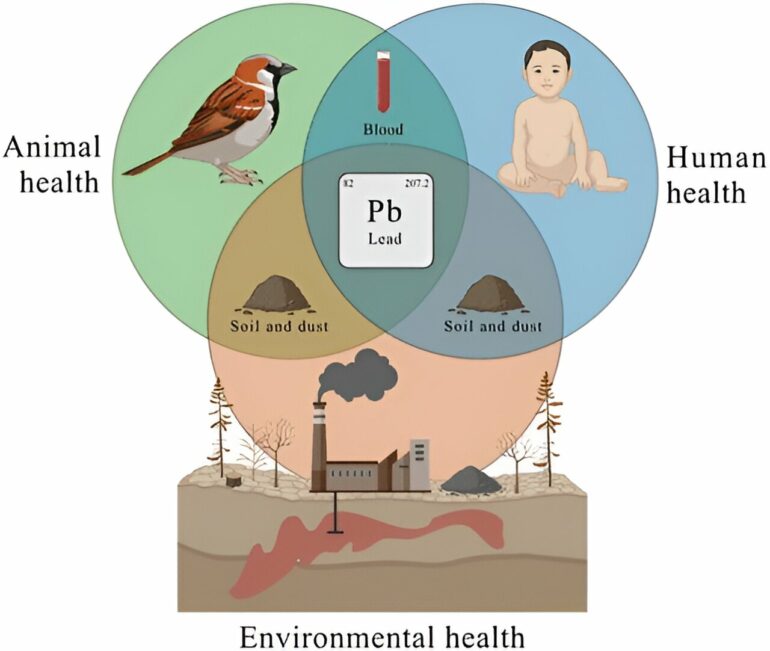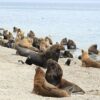Why should a medical student develop an interest in conservation? According to a growing body of evidence, including a recent study co-authored by William & Mary biologist John Swaddle, the seemingly separate fields of health sciences and conservation are inextricably linked.
The study, published in the journal Environmental Science & Technology, measured lead levels in the blood of house sparrows (Passer domesticus) in Australian mining towns to accurately predict lead levels in the blood of children living in the same areas.
“It shows that wildlife and human health are so intimately linked that when something like lead, which we know is a toxin, gets out into the environment and affects wildlife, it’s also affecting people,” said Swaddle, professor of biology and faculty director of the William & Mary Institute for Integrative Conservation (IIC).
The study illustrates the growing relevance of the One Health concept, coalescing aspects of public health, veterinary health and conservation.
Several student One Health projects are already underway at the IIC, which plans to work with conservation partners to increase their availability in the future. One Health opportunities will provide additional avenues of research to students in W&M’s popular pre-medicine and kinesiology programs.
“It’s a powerful approach,” said Swaddle, “because we know that the same living things that inhabit the same area are going to be exposed to the same risks. Whether those risks are from a toxin like lead or from a disease-causing organism, researchers can use wildlife as sentinels for human diseases.”
He evidenced One Health’s role in opening up an interest in conservation for a whole new set of people.
“There are a lot of students at W&M who are interested in the health sciences or health practices,” he said. “We want to show them that studying the environment and conservation is very relevant for public health and for human health.”
Swaddle explained that biodiversity conservation aligned with human well-being is the core work of the IIC.
“The Institute promotes and, through partnerships, applies conservation solutions that support the well-being of ecosystems and the diverse species within them,” he said. “At the same time, it promotes equitable social and sustainability practices that enhance human health and well-being,” he said.
The relationship between lead mining, house sparrows and children
For centuries, industrial activities dispersed significant amounts of lead and other heavy metals into the environment in locations around the globe, including the United States.
Swaddle explained that there is growing awareness of the inextricable connections between humans and nature and deeper recognition of the critical ecoservices that healthy ecosystems provide.
“This awareness is critically important because humans need these services to survive as a species and to thrive as communities,” he said.
According to the World Health Organization, children are particularly susceptible to the impacts of lead exposure, with health impacts that could stretch into adulthood. Finding ways to identify which areas throughout the world pose a high risk of lead contamination to children allows health officials to determine appropriate measures for remediation and avoidance.
Throughout history, animal sentinels have detected dangerous conditions. For instance, canaries were famously carried into mines as early as 1896 to warn coal miners of the presence of carbon monoxide gas. Sentinel species that have alerted humans to the presence of environmental dangers range from lichens to mammals to crustaceans.
Swaddle, for his part, has a history of studying the effects of heavy metal contamination on birds. In the locations examined by his most recent paper, significant amounts of lead have been released into the environment through lead ore extraction, processing and transport.
Choosing an appropriate sentinel species for research involves careful consideration.
“You don’t want a species that ranges all over the place, because otherwise their lead burden could be from miles and miles away,” said Swaddle.
House sparrows were identified as ideal for this research because they are non-migratory, stay within localized territories and live closely with humans. Swaddle added that they also forage on the ground and take frequent dust baths, making their exposure to lead in soil similar to that of children who crawl or play on the ground.
“The lead that you can detect in the blood of a house sparrow in a particular location is going to be associated with that specific location,” said Swaddle. “So that can give you an idea of how the people who live within that little radius are going to be exposed to that type and amount of lead.”
The researchers, led by Ph.D. student Max Gillings and Professor Simon Griffith from Macquarie University in Sydney, started their study in Broken Hill, New South Wales, where they collected blood samples from sparrows caught in sites throughout the city.
Then, they compared lead levels from those samples to data from a 30-year child blood lead monitoring program, finding a strong relationship between the two datasets across all of the sites sampled. For example, levels in both sparrows and children were higher near the mining sites and declined similarly as distance from the mining sites increased.
Next, researchers collected blood samples from sparrows in Mount Isa, Queensland, a location with lead contamination levels similar to those in Broken Hill. This time, they used the patterns discovered in Broken Hill to successfully predict the blood lead levels in Mount Isa, later confirmed by data from the child blood lead monitoring program.
“So, it’s not just studying it in one specific area and saying, ‘Oh, look, there’s a correlation between the two,'” he said. “It’s actually using it as a predictor of childhood exposure.”
The authors note that these types of studies might help determine the effectiveness of measures used to decrease lead exposure in children. For example, the correlation between lead levels in sparrows and children was strongest when compared to data from 1991, the earliest year of the child blood lead monitoring program.
At that time, both annual mining rates and child blood lead level rates were at their highest points, the authors explain. Subsequent efforts to reduce child exposure to lead may have contributed to the less robust correlation between blood lead levels in sparrows and children in more recent years.
Swaddle explained that the results of the research show the strength of the connections between people and wildlife.
“This study helps to demonstrate to people that humans are a part of nature, not apart from nature,” said Swaddle. “We’re intimately linked.”
More information:
Max M. Gillings et al, House Sparrows as Sentinels of Childhood Lead Exposure, Environmental Science & Technology (2024). DOI: 10.1021/acs.est.4c00946
Citation:
Sparrows as sentinels: Health study illustrates the interconnectedness of humans and wildlife (2024, July 4)



